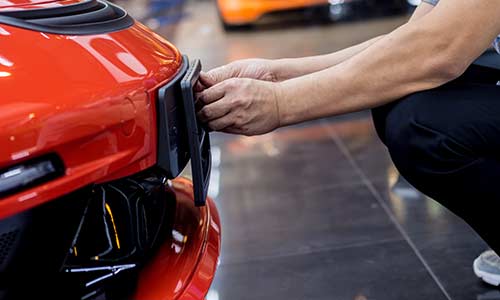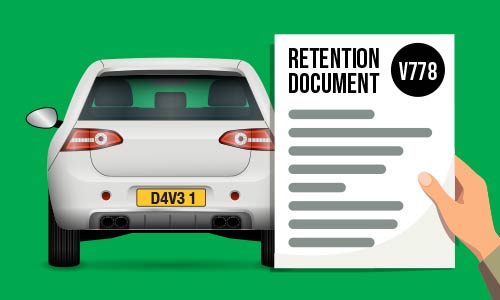Number plate valuation: How does it work?
Do you know how much your private number plate is worth? If not, it’s a good idea to find out, as it may turn out to have much more than just sentimental value.
Knowing the real market value of your private number plate can help you secure the best price if you decide to sell it.
It’s important to be aware that if you want to retain your private plate when you sell your car , you’ll have to take it off your motor before the point of sale. (Our guide to retaining a private number plate explains this process in detail.)
You might decide to hold off on selling your plate and keep it as an investment, as a premium plate can be included in your financial portfolio. You can reevaluate your private plate periodically to help you decide when it’s best to sell.
Number plate value is influenced by a range of factors, from age, rarity, and popularity, to cultural and historical significance. The length of a registration may also influence its value; shorter plates are often worth more.
In this guide, we’ll explain each of these factors in detail to help you better understand what can make a number plate valuable. We’ll also cover your options for getting your number plate evaluated – and how to read the different UK number plate formats.

Get a free valuation
Factors influencing number plate value
-
Rarity
Exclusive and unique plates are highly prized by collectors, enthusiasts, and drivers seeking something that no-one else has got. Some combinations of letters and numbers sell for millions of pounds because they’re so rare, for example: ‘BUG 1’ and ‘F1’ (UK plates), ‘D5’ (Dubai) and NSW 1 (Australia).
-
Age
Generally speaking, the older the plate, the more valuable it is. The first number plates, issued back in 1903, are some of the most valuable. These are known as ‘dateless plates’ and tend to have fewer letters and numbers to their more modern counterparts. There aren’t that many of them in circulation, which also gives them the ‘rarity’ factor.
-
Popularity
Many drivers like to make a statement about what they like and who they are with their private plates. That’s why any plates that include common names, initials, words, phrases, and/or popular culture references, are in high demand and therefore, worth more.
Examples include:
-
L4 URA
-
S1NGH
-
1 NHS
-
K155 XXX
-
B16 BOY
-
AR53 NAL
-
SH3RLOK
-
007 JB
-
-
Number of characters
Plates with only a few characters are more desirable. The fewer characters a plate has, the more it’s likely to be worth.
A plate with only with a few digits is likely to be rarer and older. Significant numbers such as ‘18’ and ‘21’ also push the price up, as do sequential and repeated numbers, such as ‘123’ and ‘555’.
-
Quality and clarity
How well a plate represents a word or name (also known as its ‘match quality’) has a bearing on its value. The aim is for the plate to be instantly recognisable as a particular word or name, without the reader having to decipher it.
For example: ‘4ND R3W’ is easier to understand, and therefore more desirable, than ‘4HD REVV’.
-
Historical significance and associations
Plates with celebrity links are highly prized, such as ‘VIP 1’ (formerly assigned to Pope John Paul II), ‘250 L’ (owned by Eric Clapton), and ‘MAG 1C’ (formerly owned by Paul Daniels), as are those with historical significance, such as ‘A1’, the very first UK number plate, which was issued in 1903.
Valuation process
You have two options when it comes to getting a private number plate valuation:
-
There are many free online tools available, including the DVLA’s Personalised Registration lookup tool. All are easy to use and will give you a quick result. Just enter your reg number and they’ll find the current value of your plate.
-
There are also specialist number plate dealers. You won’t get an instant result from these dealers (and you may also have to pay a fee), but you will get the benefit of their experience.
Although free online tools are certainly convenient, it can also be helpful to get an expert assessment. A specialised dealer will have a detailed understanding of the many variables that feed into how much a number plate is worth.
Without an expert appraisal, you could end up losing a lot of money. It’s also worth shopping around to ensure you get the best possible price for your plate.
Number plate examples
-
The world’s most valuable number plate, ‘7’ recently sold for £12 million.
-
‘F1’ is a close second (currently worth £10 million).
-
‘9’, ‘8’, ‘5’, and ‘1’ are all valued at between £7 and £8 million pounds.
-
‘S1’, ‘M1’, ‘X1’, and ‘G1’ are all valued at £1 million.
Number plates have evolved over the years. From 1963 onwards, UK number plates have contained codified information, which tells you what year the car was registered.
Here’s a quick breakdown of the different number plate styles and what they mean:
Dateless plates (1903 to 1963): These consist of three numbers and three letters, which could be either way round, for example, ‘ABC 123’ or ‘123 ABC’. They’re called ‘dateless’ registration plates, as it is not possible to read them to determine the vehicle’s age.
Suffix style plates (1963 to 1983): These have three letters and three numbers, followed by another letter that stands for the year they were issued, for example, ‘ABC 123A’. Suffix style plates are often seen on classic cars.
Prefix style plates (1983 to 2001): With prefix style plates, the letter corresponding to the year of issue comes first, for example ‘A123 ABC’.
Current style plates (2001 to present): These have a different format altogether, with two letters, two numbers, and three letters, such as ‘AB12 ABC’. The first two letters and numbers represent where and when the car was registered.
Northern Irish plates: These have three letters and up to four numbers, such as ‘ABC 1234’. These are also dateless.










